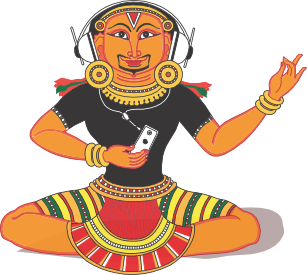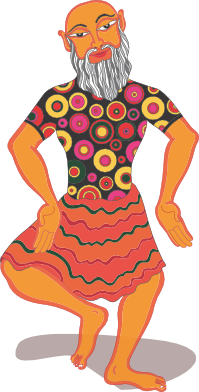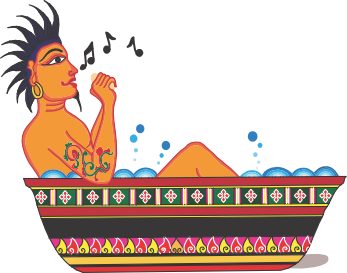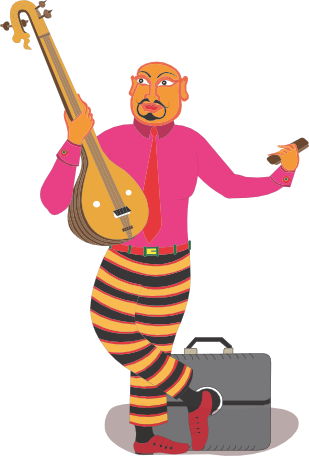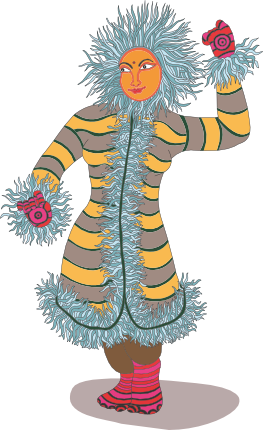Posted by admin in Oldblog
on Jul 26th, 2012 | 0 comments
Mohiniāṭṭam
Mohiniāṭṭam is a dance form from Kerala in south-western India. The term Mohiniāṭṭam literally means ‘Dance of the Enchantress’. Mohiniāṭṭam was performed in the temple precincts of Keraḷa. It developed from the Dhévadhāsi dance system just like Bharathanātyam, Kūchipūḍi and Oḍissi. The word ‘Mohini’ refers to a maiden who exerts desire or steals the heart of the onlooker. There is a well known story of Lord Viṣhṇu taking on the guise of ‘Mohini’ to enthrall people, once in the Kūrmavathāram to distract the asuras and once to slay Bhasmāsurā.

History:The earliest known textual reference to Mohiniāṭṭam can be found in the Vyāvaharamāla, a Sanskrit text written by Mazhamangalam Nambūdhiri in the 16th century. Another reference on Mohiniāṭṭam can be found in the Oṭṭanthuḷḷal (a semi-classical and semi-folk dramatic art form of Keraḷa) script Ghośhayāthrā, authored by Kunchan Nambiār in the 18th century. The male members of the affluent and powerful Nambūdhiri and Nāir families exploited the Mohiniāṭṭam dancers. Gradually the dance was considered inappropriate and there were few takers for it. There is a considerable amount of disagreement among scholars regarding the antiquity of Mohiniāṭṭam. Most of them agree that it was during Maharāja Swāthi Thirunāl‘s rule in the 16th century that Mohiniāṭṭam achieved its refined form. The Maharāja of Travancore was a great patron of the arts and encouraged artistes, singers, dancers from all over the country to come and perform in his court. Bharathanātyam which was brought into Keraḷa by the Tanjore Quartet influenced Mohiniāṭṭam. The Maharājā was a great bhaktha of Lord Padhmanābhha and composed innumerable kruthis, padhams and varṇams in Hindusthāni as well as Karnātic rāgās, in his praise. The Maharājā’s padhams are always a part of a Mohiniāṭṭam dancer’s repertoire.

It was in the 20th century that Mohiniāṭṭam flourished. When Mahākavi Vaḷḷathōl set up his premiere institution for Kathakaḷi, the Keraḷa Kalāmaṇḍalam, he invited three famous Mohiniāṭṭam dancers, Kalpurathe Kunjukuṭṭi Ammā, Thoṭṭachéri Chinnamuammā and Kalyāṇi Kuṭṭi Ammā to teach Mohiniāṭṭam in his institution. Due to the relentless work of researchers, scholars, performers of Mohiniāṭṭam, the dance form has achieved its present classical standing. Scholar-poet and theater thespian Kāvālam Nārāyaṇa Paṇikkar came forward with new compositions and researched theories so as to prevent Mohiniāṭṭam from imitating the Bharathanātyam repertoire, by emphasizing on the aesthetics and ethnic influence of the art form.

Costume: The Mohiniāṭṭam costume is always white or off white with gold or red border. Today, different coloured borders are used. Some dancers tie their costumes in a way similar to that of Bharathanātyam. Usually, Mohiniāṭṭam dancers tie their hair in a bundle on the left side with white flowers, and a simple ornament tied on the bun. A choker and a long chain (kāśhumālā) adorn the neck of the dancer. For the ears the dancer wears a ‘thōḍu’ which is circular coin like earring with Jhimkis or dangling earrings. The waist belt is also used .The makeup is done with emphasis given to the eyes.
Compiled by: Aarthi Natarajan & Indira Kadambi
